Annotated Bibliographies Handout | Howe Center for Writing
VerifiedAdded on 2022/08/23
|12
|2914
|11
AI Summary
Contribute Materials
Your contribution can guide someone’s learning journey. Share your
documents today.
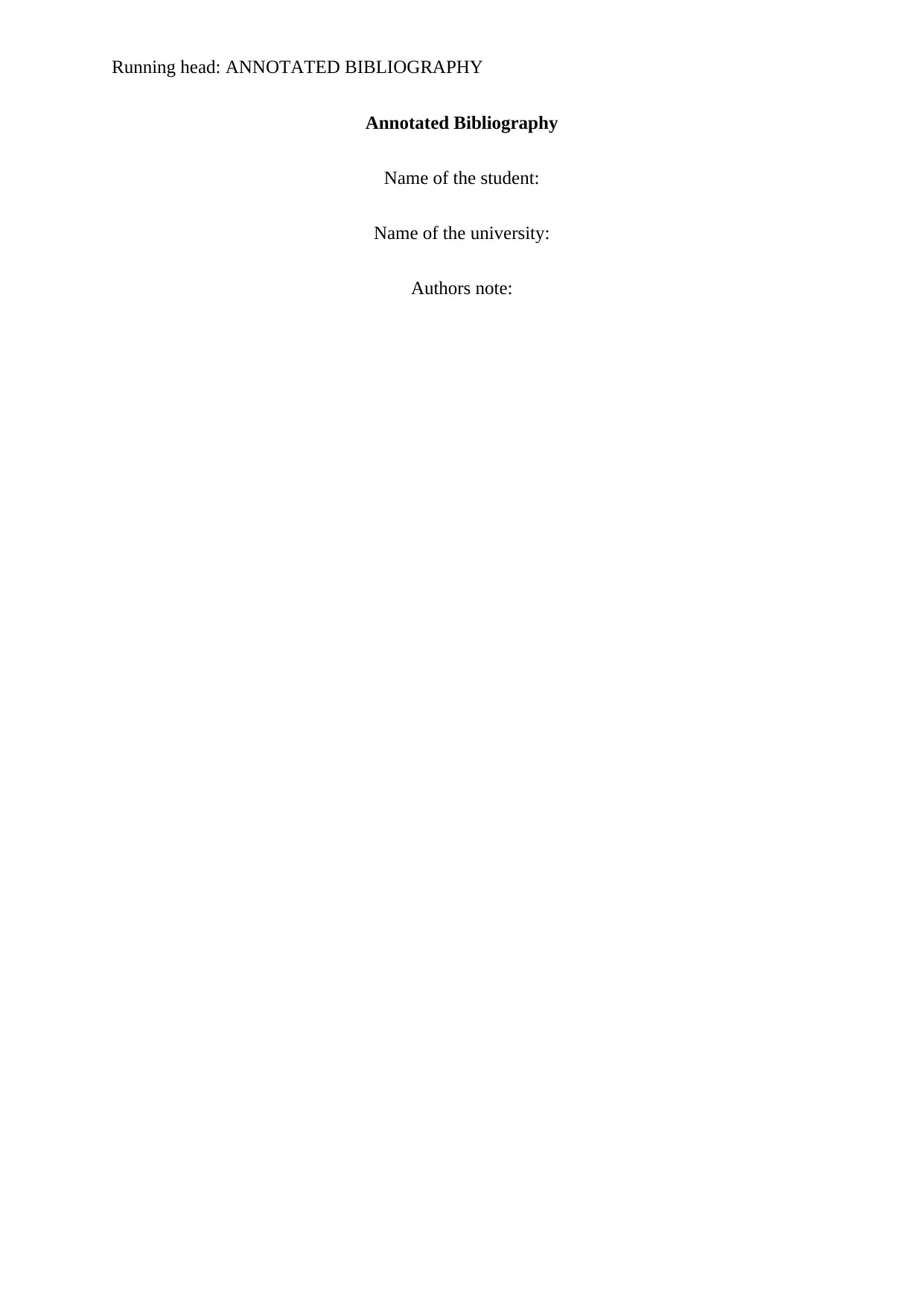
Running head: ANNOTATED BIBLIOGRAPHY
Annotated Bibliography
Name of the student:
Name of the university:
Authors note:
Annotated Bibliography
Name of the student:
Name of the university:
Authors note:
Secure Best Marks with AI Grader
Need help grading? Try our AI Grader for instant feedback on your assignments.
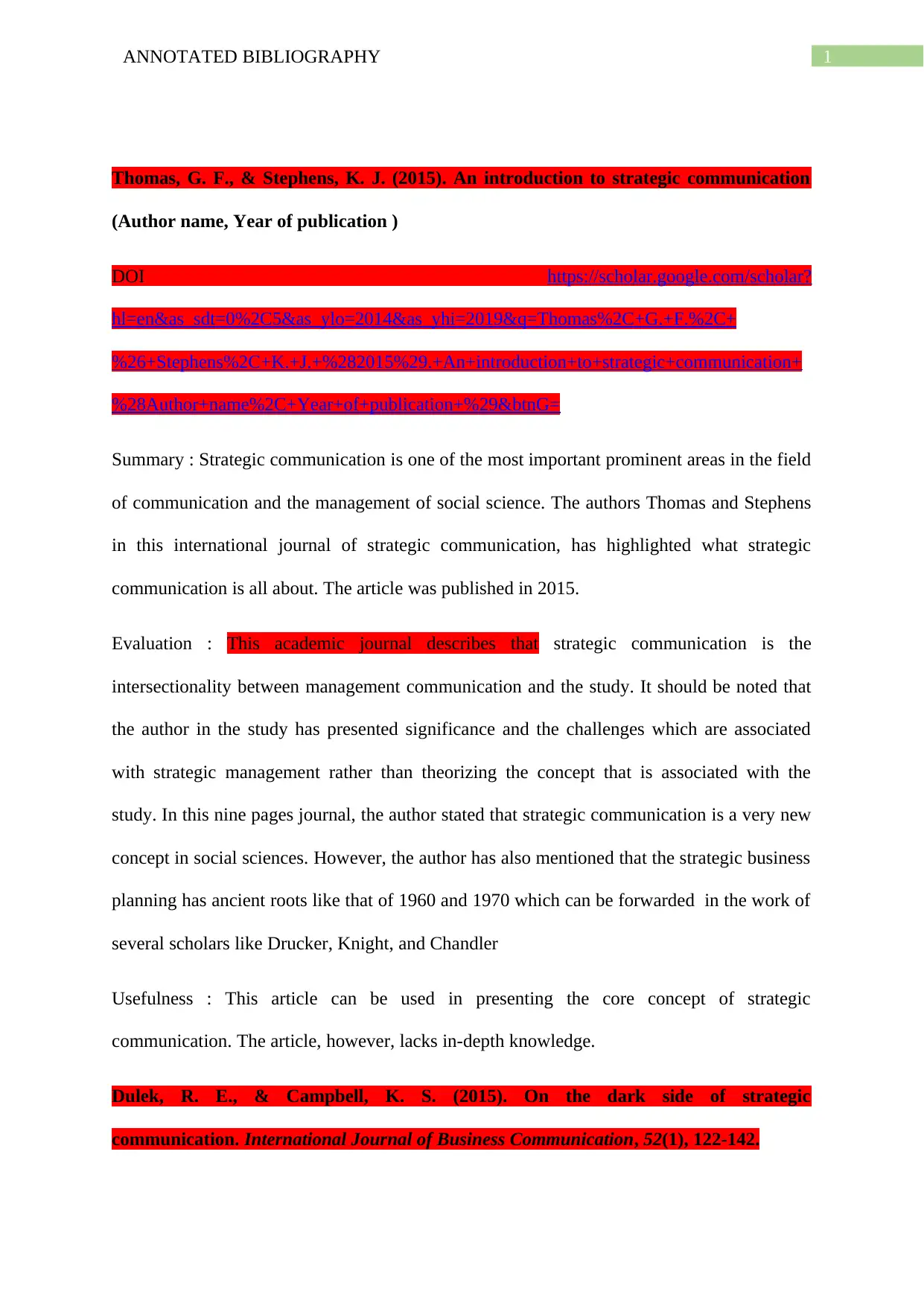
1ANNOTATED BIBLIOGRAPHY
Thomas, G. F., & Stephens, K. J. (2015). An introduction to strategic communication
(Author name, Year of publication )
DOI https://scholar.google.com/scholar?
hl=en&as_sdt=0%2C5&as_ylo=2014&as_yhi=2019&q=Thomas%2C+G.+F.%2C+
%26+Stephens%2C+K.+J.+%282015%29.+An+introduction+to+strategic+communication+
%28Author+name%2C+Year+of+publication+%29&btnG=
Summary : Strategic communication is one of the most important prominent areas in the field
of communication and the management of social science. The authors Thomas and Stephens
in this international journal of strategic communication, has highlighted what strategic
communication is all about. The article was published in 2015.
Evaluation : This academic journal describes that strategic communication is the
intersectionality between management communication and the study. It should be noted that
the author in the study has presented significance and the challenges which are associated
with strategic management rather than theorizing the concept that is associated with the
study. In this nine pages journal, the author stated that strategic communication is a very new
concept in social sciences. However, the author has also mentioned that the strategic business
planning has ancient roots like that of 1960 and 1970 which can be forwarded in the work of
several scholars like Drucker, Knight, and Chandler
Usefulness : This article can be used in presenting the core concept of strategic
communication. The article, however, lacks in-depth knowledge.
Dulek, R. E., & Campbell, K. S. (2015). On the dark side of strategic
communication. International Journal of Business Communication, 52(1), 122-142.
Thomas, G. F., & Stephens, K. J. (2015). An introduction to strategic communication
(Author name, Year of publication )
DOI https://scholar.google.com/scholar?
hl=en&as_sdt=0%2C5&as_ylo=2014&as_yhi=2019&q=Thomas%2C+G.+F.%2C+
%26+Stephens%2C+K.+J.+%282015%29.+An+introduction+to+strategic+communication+
%28Author+name%2C+Year+of+publication+%29&btnG=
Summary : Strategic communication is one of the most important prominent areas in the field
of communication and the management of social science. The authors Thomas and Stephens
in this international journal of strategic communication, has highlighted what strategic
communication is all about. The article was published in 2015.
Evaluation : This academic journal describes that strategic communication is the
intersectionality between management communication and the study. It should be noted that
the author in the study has presented significance and the challenges which are associated
with strategic management rather than theorizing the concept that is associated with the
study. In this nine pages journal, the author stated that strategic communication is a very new
concept in social sciences. However, the author has also mentioned that the strategic business
planning has ancient roots like that of 1960 and 1970 which can be forwarded in the work of
several scholars like Drucker, Knight, and Chandler
Usefulness : This article can be used in presenting the core concept of strategic
communication. The article, however, lacks in-depth knowledge.
Dulek, R. E., & Campbell, K. S. (2015). On the dark side of strategic
communication. International Journal of Business Communication, 52(1), 122-142.
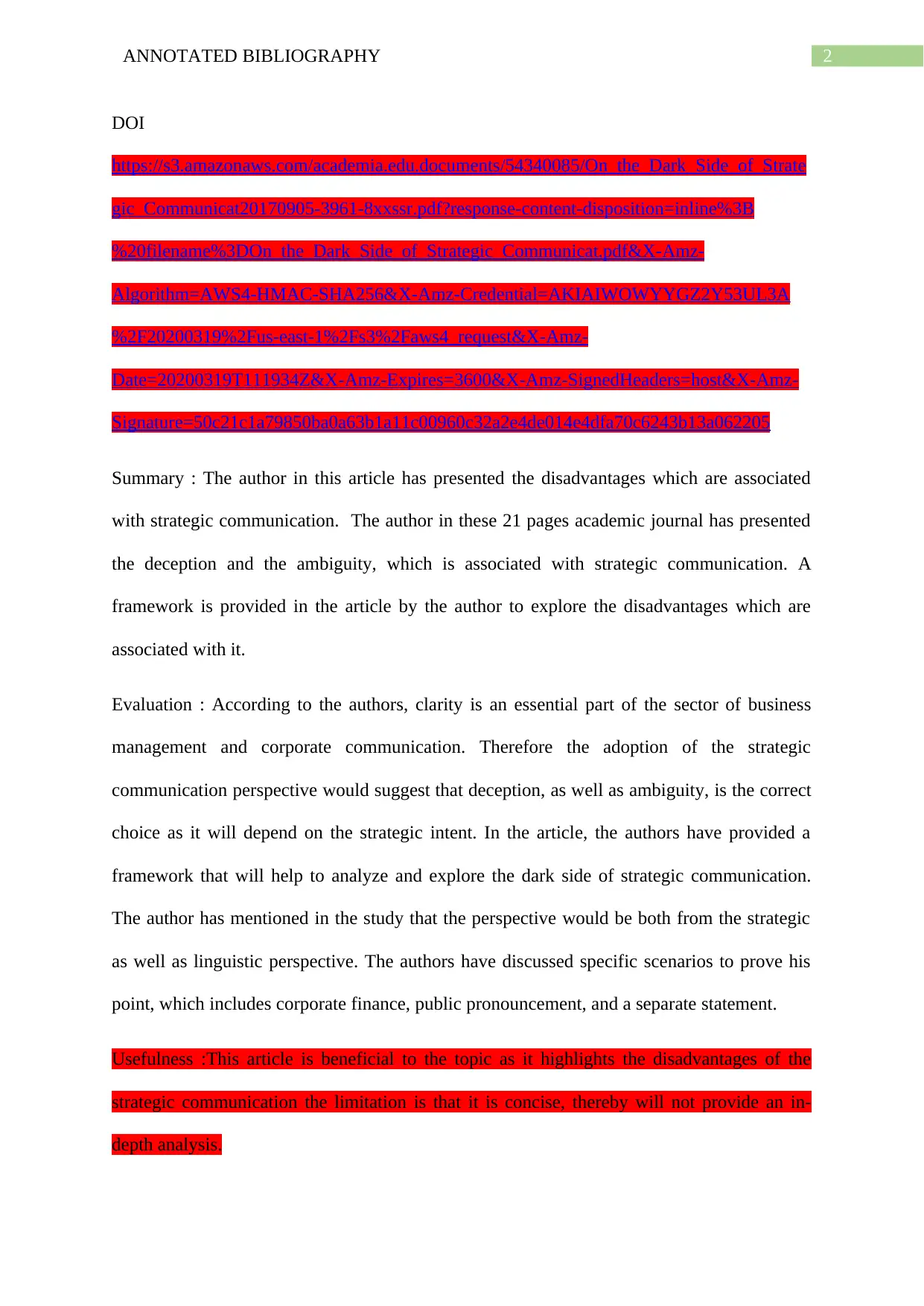
2ANNOTATED BIBLIOGRAPHY
DOI
https://s3.amazonaws.com/academia.edu.documents/54340085/On_the_Dark_Side_of_Strate
gic_Communicat20170905-3961-8xxssr.pdf?response-content-disposition=inline%3B
%20filename%3DOn_the_Dark_Side_of_Strategic_Communicat.pdf&X-Amz-
Algorithm=AWS4-HMAC-SHA256&X-Amz-Credential=AKIAIWOWYYGZ2Y53UL3A
%2F20200319%2Fus-east-1%2Fs3%2Faws4_request&X-Amz-
Date=20200319T111934Z&X-Amz-Expires=3600&X-Amz-SignedHeaders=host&X-Amz-
Signature=50c21c1a79850ba0a63b1a11c00960c32a2e4de014e4dfa70c6243b13a062205
Summary : The author in this article has presented the disadvantages which are associated
with strategic communication. The author in these 21 pages academic journal has presented
the deception and the ambiguity, which is associated with strategic communication. A
framework is provided in the article by the author to explore the disadvantages which are
associated with it.
Evaluation : According to the authors, clarity is an essential part of the sector of business
management and corporate communication. Therefore the adoption of the strategic
communication perspective would suggest that deception, as well as ambiguity, is the correct
choice as it will depend on the strategic intent. In the article, the authors have provided a
framework that will help to analyze and explore the dark side of strategic communication.
The author has mentioned in the study that the perspective would be both from the strategic
as well as linguistic perspective. The authors have discussed specific scenarios to prove his
point, which includes corporate finance, public pronouncement, and a separate statement.
Usefulness :This article is beneficial to the topic as it highlights the disadvantages of the
strategic communication the limitation is that it is concise, thereby will not provide an in-
depth analysis.
DOI
https://s3.amazonaws.com/academia.edu.documents/54340085/On_the_Dark_Side_of_Strate
gic_Communicat20170905-3961-8xxssr.pdf?response-content-disposition=inline%3B
%20filename%3DOn_the_Dark_Side_of_Strategic_Communicat.pdf&X-Amz-
Algorithm=AWS4-HMAC-SHA256&X-Amz-Credential=AKIAIWOWYYGZ2Y53UL3A
%2F20200319%2Fus-east-1%2Fs3%2Faws4_request&X-Amz-
Date=20200319T111934Z&X-Amz-Expires=3600&X-Amz-SignedHeaders=host&X-Amz-
Signature=50c21c1a79850ba0a63b1a11c00960c32a2e4de014e4dfa70c6243b13a062205
Summary : The author in this article has presented the disadvantages which are associated
with strategic communication. The author in these 21 pages academic journal has presented
the deception and the ambiguity, which is associated with strategic communication. A
framework is provided in the article by the author to explore the disadvantages which are
associated with it.
Evaluation : According to the authors, clarity is an essential part of the sector of business
management and corporate communication. Therefore the adoption of the strategic
communication perspective would suggest that deception, as well as ambiguity, is the correct
choice as it will depend on the strategic intent. In the article, the authors have provided a
framework that will help to analyze and explore the dark side of strategic communication.
The author has mentioned in the study that the perspective would be both from the strategic
as well as linguistic perspective. The authors have discussed specific scenarios to prove his
point, which includes corporate finance, public pronouncement, and a separate statement.
Usefulness :This article is beneficial to the topic as it highlights the disadvantages of the
strategic communication the limitation is that it is concise, thereby will not provide an in-
depth analysis.
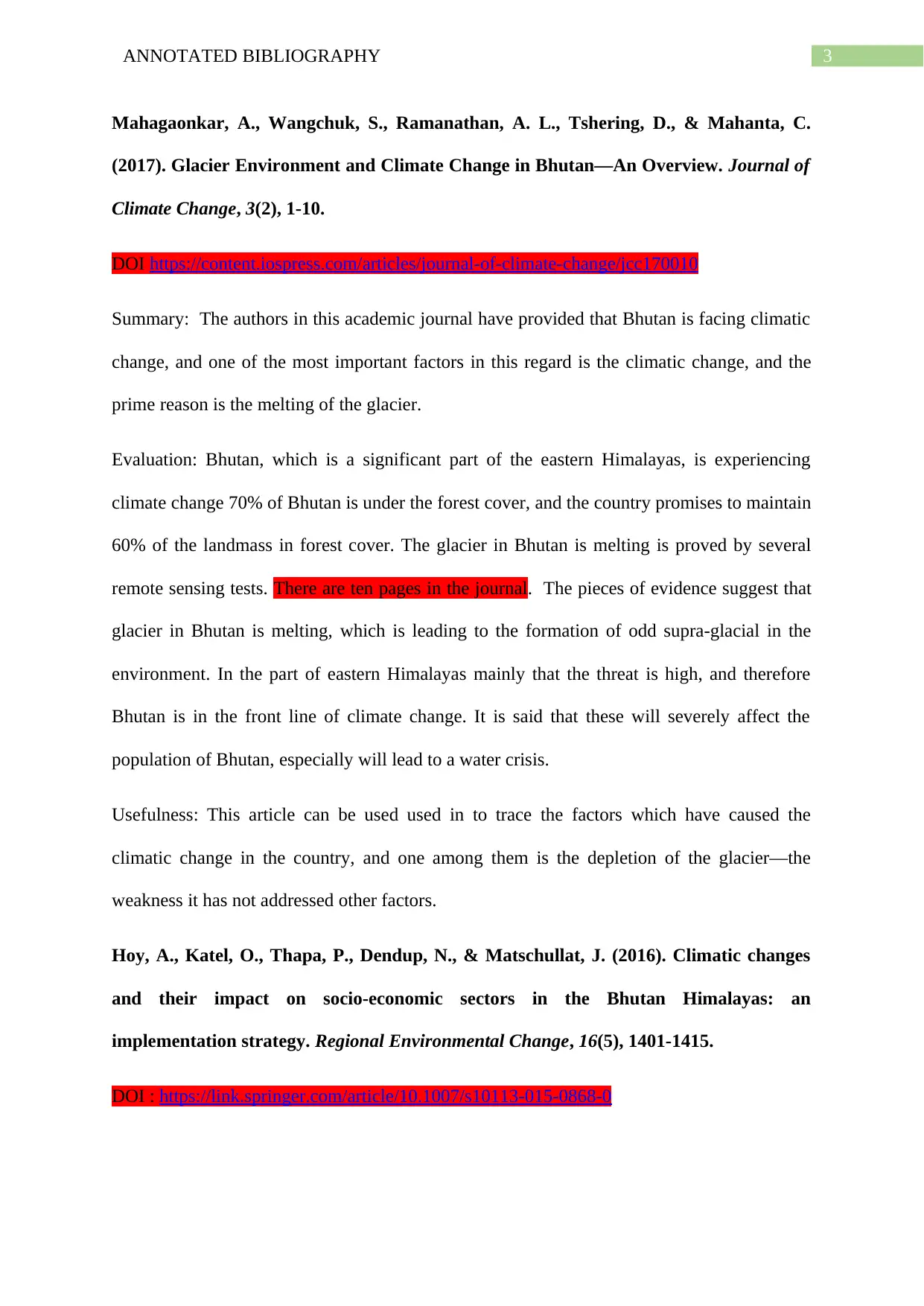
3ANNOTATED BIBLIOGRAPHY
Mahagaonkar, A., Wangchuk, S., Ramanathan, A. L., Tshering, D., & Mahanta, C.
(2017). Glacier Environment and Climate Change in Bhutan—An Overview. Journal of
Climate Change, 3(2), 1-10.
DOI https://content.iospress.com/articles/journal-of-climate-change/jcc170010
Summary: The authors in this academic journal have provided that Bhutan is facing climatic
change, and one of the most important factors in this regard is the climatic change, and the
prime reason is the melting of the glacier.
Evaluation: Bhutan, which is a significant part of the eastern Himalayas, is experiencing
climate change 70% of Bhutan is under the forest cover, and the country promises to maintain
60% of the landmass in forest cover. The glacier in Bhutan is melting is proved by several
remote sensing tests. There are ten pages in the journal. The pieces of evidence suggest that
glacier in Bhutan is melting, which is leading to the formation of odd supra-glacial in the
environment. In the part of eastern Himalayas mainly that the threat is high, and therefore
Bhutan is in the front line of climate change. It is said that these will severely affect the
population of Bhutan, especially will lead to a water crisis.
Usefulness: This article can be used used in to trace the factors which have caused the
climatic change in the country, and one among them is the depletion of the glacier—the
weakness it has not addressed other factors.
Hoy, A., Katel, O., Thapa, P., Dendup, N., & Matschullat, J. (2016). Climatic changes
and their impact on socio-economic sectors in the Bhutan Himalayas: an
implementation strategy. Regional Environmental Change, 16(5), 1401-1415.
DOI : https://link.springer.com/article/10.1007/s10113-015-0868-0
Mahagaonkar, A., Wangchuk, S., Ramanathan, A. L., Tshering, D., & Mahanta, C.
(2017). Glacier Environment and Climate Change in Bhutan—An Overview. Journal of
Climate Change, 3(2), 1-10.
DOI https://content.iospress.com/articles/journal-of-climate-change/jcc170010
Summary: The authors in this academic journal have provided that Bhutan is facing climatic
change, and one of the most important factors in this regard is the climatic change, and the
prime reason is the melting of the glacier.
Evaluation: Bhutan, which is a significant part of the eastern Himalayas, is experiencing
climate change 70% of Bhutan is under the forest cover, and the country promises to maintain
60% of the landmass in forest cover. The glacier in Bhutan is melting is proved by several
remote sensing tests. There are ten pages in the journal. The pieces of evidence suggest that
glacier in Bhutan is melting, which is leading to the formation of odd supra-glacial in the
environment. In the part of eastern Himalayas mainly that the threat is high, and therefore
Bhutan is in the front line of climate change. It is said that these will severely affect the
population of Bhutan, especially will lead to a water crisis.
Usefulness: This article can be used used in to trace the factors which have caused the
climatic change in the country, and one among them is the depletion of the glacier—the
weakness it has not addressed other factors.
Hoy, A., Katel, O., Thapa, P., Dendup, N., & Matschullat, J. (2016). Climatic changes
and their impact on socio-economic sectors in the Bhutan Himalayas: an
implementation strategy. Regional Environmental Change, 16(5), 1401-1415.
DOI : https://link.springer.com/article/10.1007/s10113-015-0868-0
Secure Best Marks with AI Grader
Need help grading? Try our AI Grader for instant feedback on your assignments.
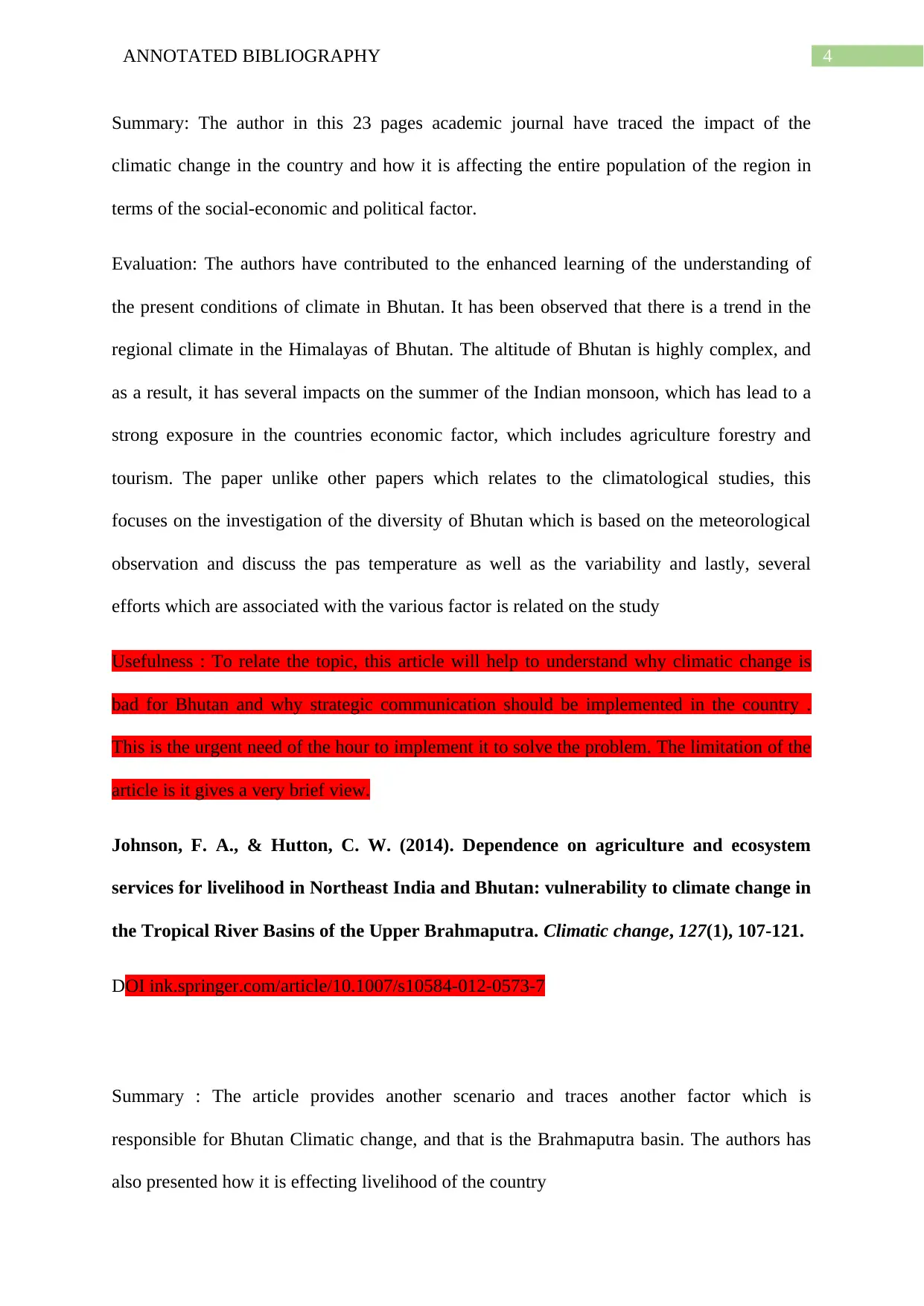
4ANNOTATED BIBLIOGRAPHY
Summary: The author in this 23 pages academic journal have traced the impact of the
climatic change in the country and how it is affecting the entire population of the region in
terms of the social-economic and political factor.
Evaluation: The authors have contributed to the enhanced learning of the understanding of
the present conditions of climate in Bhutan. It has been observed that there is a trend in the
regional climate in the Himalayas of Bhutan. The altitude of Bhutan is highly complex, and
as a result, it has several impacts on the summer of the Indian monsoon, which has lead to a
strong exposure in the countries economic factor, which includes agriculture forestry and
tourism. The paper unlike other papers which relates to the climatological studies, this
focuses on the investigation of the diversity of Bhutan which is based on the meteorological
observation and discuss the pas temperature as well as the variability and lastly, several
efforts which are associated with the various factor is related on the study
Usefulness : To relate the topic, this article will help to understand why climatic change is
bad for Bhutan and why strategic communication should be implemented in the country .
This is the urgent need of the hour to implement it to solve the problem. The limitation of the
article is it gives a very brief view.
Johnson, F. A., & Hutton, C. W. (2014). Dependence on agriculture and ecosystem
services for livelihood in Northeast India and Bhutan: vulnerability to climate change in
the Tropical River Basins of the Upper Brahmaputra. Climatic change, 127(1), 107-121.
DOI ink.springer.com/article/10.1007/s10584-012-0573-7
Summary : The article provides another scenario and traces another factor which is
responsible for Bhutan Climatic change, and that is the Brahmaputra basin. The authors has
also presented how it is effecting livelihood of the country
Summary: The author in this 23 pages academic journal have traced the impact of the
climatic change in the country and how it is affecting the entire population of the region in
terms of the social-economic and political factor.
Evaluation: The authors have contributed to the enhanced learning of the understanding of
the present conditions of climate in Bhutan. It has been observed that there is a trend in the
regional climate in the Himalayas of Bhutan. The altitude of Bhutan is highly complex, and
as a result, it has several impacts on the summer of the Indian monsoon, which has lead to a
strong exposure in the countries economic factor, which includes agriculture forestry and
tourism. The paper unlike other papers which relates to the climatological studies, this
focuses on the investigation of the diversity of Bhutan which is based on the meteorological
observation and discuss the pas temperature as well as the variability and lastly, several
efforts which are associated with the various factor is related on the study
Usefulness : To relate the topic, this article will help to understand why climatic change is
bad for Bhutan and why strategic communication should be implemented in the country .
This is the urgent need of the hour to implement it to solve the problem. The limitation of the
article is it gives a very brief view.
Johnson, F. A., & Hutton, C. W. (2014). Dependence on agriculture and ecosystem
services for livelihood in Northeast India and Bhutan: vulnerability to climate change in
the Tropical River Basins of the Upper Brahmaputra. Climatic change, 127(1), 107-121.
DOI ink.springer.com/article/10.1007/s10584-012-0573-7
Summary : The article provides another scenario and traces another factor which is
responsible for Bhutan Climatic change, and that is the Brahmaputra basin. The authors has
also presented how it is effecting livelihood of the country
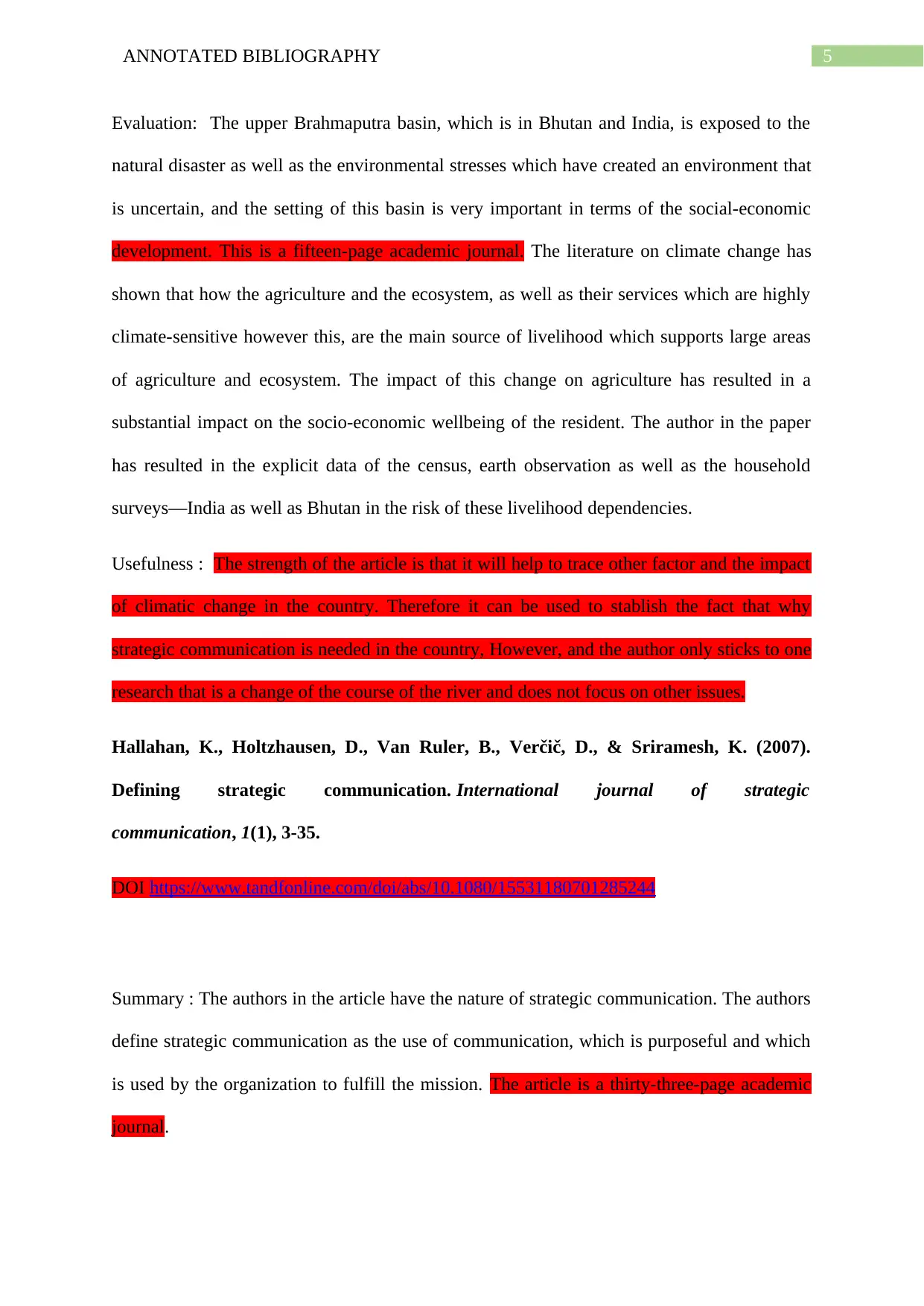
5ANNOTATED BIBLIOGRAPHY
Evaluation: The upper Brahmaputra basin, which is in Bhutan and India, is exposed to the
natural disaster as well as the environmental stresses which have created an environment that
is uncertain, and the setting of this basin is very important in terms of the social-economic
development. This is a fifteen-page academic journal. The literature on climate change has
shown that how the agriculture and the ecosystem, as well as their services which are highly
climate-sensitive however this, are the main source of livelihood which supports large areas
of agriculture and ecosystem. The impact of this change on agriculture has resulted in a
substantial impact on the socio-economic wellbeing of the resident. The author in the paper
has resulted in the explicit data of the census, earth observation as well as the household
surveys—India as well as Bhutan in the risk of these livelihood dependencies.
Usefulness : The strength of the article is that it will help to trace other factor and the impact
of climatic change in the country. Therefore it can be used to stablish the fact that why
strategic communication is needed in the country, However, and the author only sticks to one
research that is a change of the course of the river and does not focus on other issues.
Hallahan, K., Holtzhausen, D., Van Ruler, B., Verčič, D., & Sriramesh, K. (2007).
Defining strategic communication. International journal of strategic
communication, 1(1), 3-35.
DOI https://www.tandfonline.com/doi/abs/10.1080/15531180701285244
Summary : The authors in the article have the nature of strategic communication. The authors
define strategic communication as the use of communication, which is purposeful and which
is used by the organization to fulfill the mission. The article is a thirty-three-page academic
journal.
Evaluation: The upper Brahmaputra basin, which is in Bhutan and India, is exposed to the
natural disaster as well as the environmental stresses which have created an environment that
is uncertain, and the setting of this basin is very important in terms of the social-economic
development. This is a fifteen-page academic journal. The literature on climate change has
shown that how the agriculture and the ecosystem, as well as their services which are highly
climate-sensitive however this, are the main source of livelihood which supports large areas
of agriculture and ecosystem. The impact of this change on agriculture has resulted in a
substantial impact on the socio-economic wellbeing of the resident. The author in the paper
has resulted in the explicit data of the census, earth observation as well as the household
surveys—India as well as Bhutan in the risk of these livelihood dependencies.
Usefulness : The strength of the article is that it will help to trace other factor and the impact
of climatic change in the country. Therefore it can be used to stablish the fact that why
strategic communication is needed in the country, However, and the author only sticks to one
research that is a change of the course of the river and does not focus on other issues.
Hallahan, K., Holtzhausen, D., Van Ruler, B., Verčič, D., & Sriramesh, K. (2007).
Defining strategic communication. International journal of strategic
communication, 1(1), 3-35.
DOI https://www.tandfonline.com/doi/abs/10.1080/15531180701285244
Summary : The authors in the article have the nature of strategic communication. The authors
define strategic communication as the use of communication, which is purposeful and which
is used by the organization to fulfill the mission. The article is a thirty-three-page academic
journal.
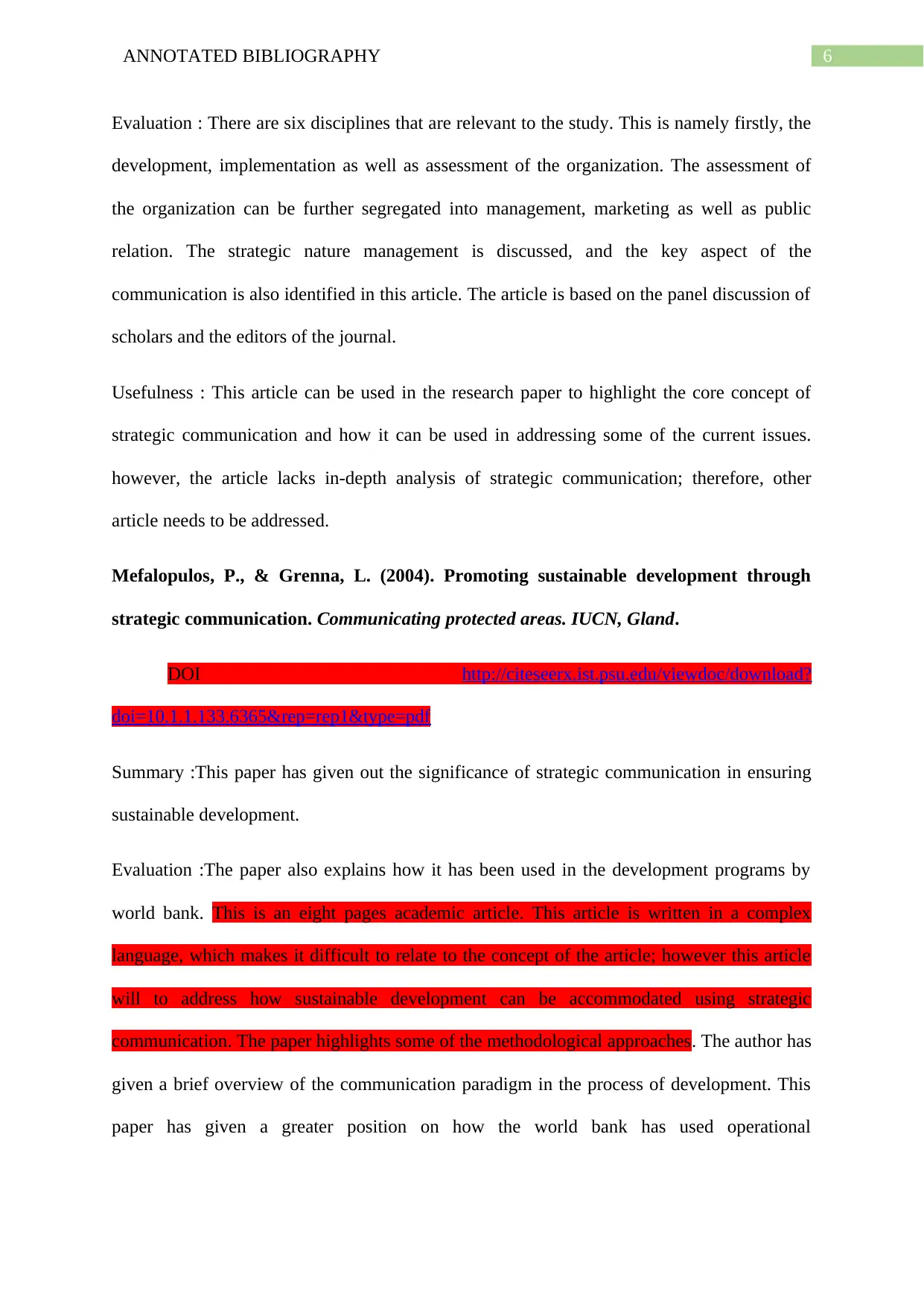
6ANNOTATED BIBLIOGRAPHY
Evaluation : There are six disciplines that are relevant to the study. This is namely firstly, the
development, implementation as well as assessment of the organization. The assessment of
the organization can be further segregated into management, marketing as well as public
relation. The strategic nature management is discussed, and the key aspect of the
communication is also identified in this article. The article is based on the panel discussion of
scholars and the editors of the journal.
Usefulness : This article can be used in the research paper to highlight the core concept of
strategic communication and how it can be used in addressing some of the current issues.
however, the article lacks in-depth analysis of strategic communication; therefore, other
article needs to be addressed.
Mefalopulos, P., & Grenna, L. (2004). Promoting sustainable development through
strategic communication. Communicating protected areas. IUCN, Gland.
DOI http://citeseerx.ist.psu.edu/viewdoc/download?
doi=10.1.1.133.6365&rep=rep1&type=pdf
Summary :This paper has given out the significance of strategic communication in ensuring
sustainable development.
Evaluation :The paper also explains how it has been used in the development programs by
world bank. This is an eight pages academic article. This article is written in a complex
language, which makes it difficult to relate to the concept of the article; however this article
will to address how sustainable development can be accommodated using strategic
communication. The paper highlights some of the methodological approaches. The author has
given a brief overview of the communication paradigm in the process of development. This
paper has given a greater position on how the world bank has used operational
Evaluation : There are six disciplines that are relevant to the study. This is namely firstly, the
development, implementation as well as assessment of the organization. The assessment of
the organization can be further segregated into management, marketing as well as public
relation. The strategic nature management is discussed, and the key aspect of the
communication is also identified in this article. The article is based on the panel discussion of
scholars and the editors of the journal.
Usefulness : This article can be used in the research paper to highlight the core concept of
strategic communication and how it can be used in addressing some of the current issues.
however, the article lacks in-depth analysis of strategic communication; therefore, other
article needs to be addressed.
Mefalopulos, P., & Grenna, L. (2004). Promoting sustainable development through
strategic communication. Communicating protected areas. IUCN, Gland.
DOI http://citeseerx.ist.psu.edu/viewdoc/download?
doi=10.1.1.133.6365&rep=rep1&type=pdf
Summary :This paper has given out the significance of strategic communication in ensuring
sustainable development.
Evaluation :The paper also explains how it has been used in the development programs by
world bank. This is an eight pages academic article. This article is written in a complex
language, which makes it difficult to relate to the concept of the article; however this article
will to address how sustainable development can be accommodated using strategic
communication. The paper highlights some of the methodological approaches. The author has
given a brief overview of the communication paradigm in the process of development. This
paper has given a greater position on how the world bank has used operational
Paraphrase This Document
Need a fresh take? Get an instant paraphrase of this document with our AI Paraphraser
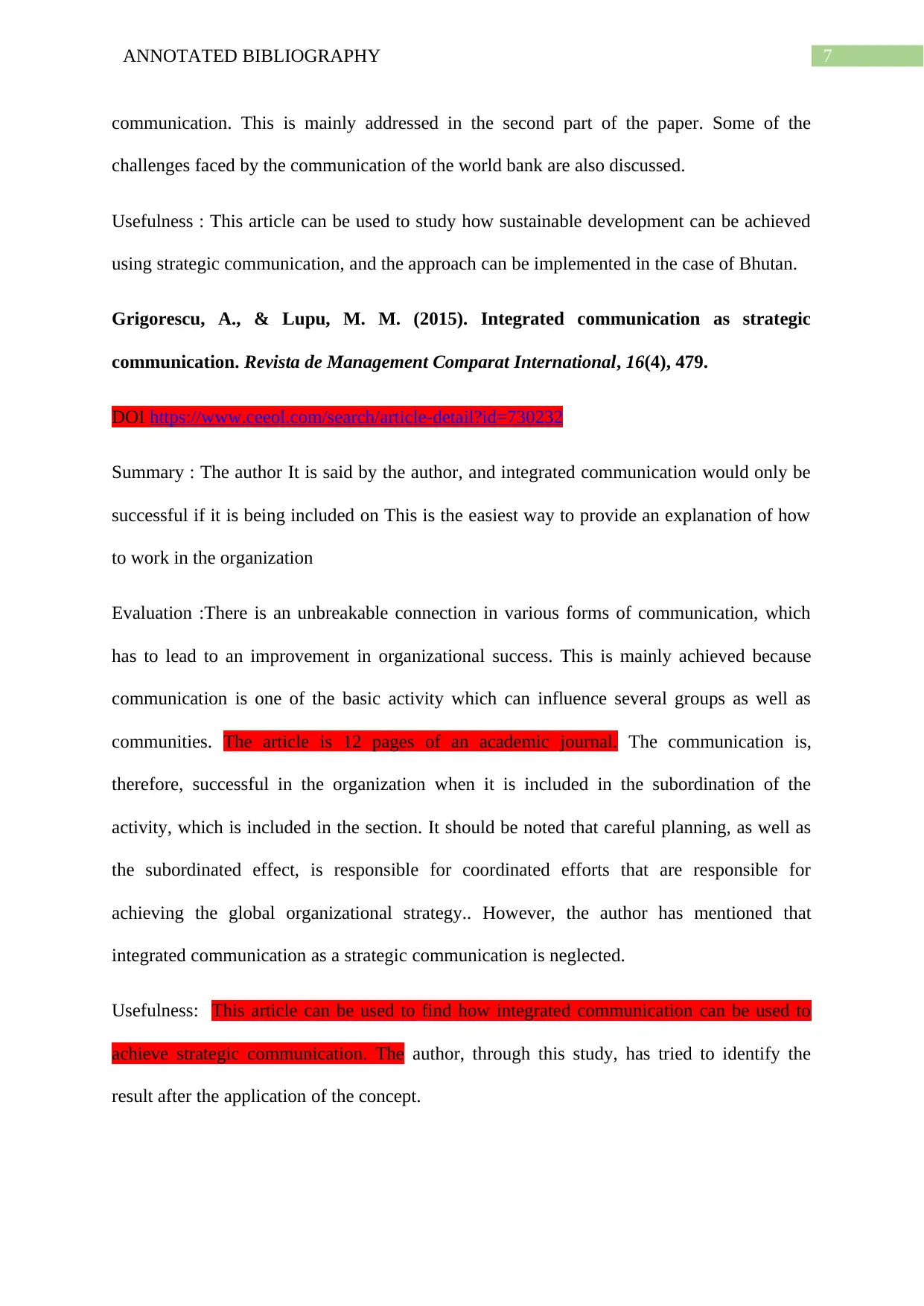
7ANNOTATED BIBLIOGRAPHY
communication. This is mainly addressed in the second part of the paper. Some of the
challenges faced by the communication of the world bank are also discussed.
Usefulness : This article can be used to study how sustainable development can be achieved
using strategic communication, and the approach can be implemented in the case of Bhutan.
Grigorescu, A., & Lupu, M. M. (2015). Integrated communication as strategic
communication. Revista de Management Comparat International, 16(4), 479.
DOI https://www.ceeol.com/search/article-detail?id=730232
Summary : The author It is said by the author, and integrated communication would only be
successful if it is being included on This is the easiest way to provide an explanation of how
to work in the organization
Evaluation :There is an unbreakable connection in various forms of communication, which
has to lead to an improvement in organizational success. This is mainly achieved because
communication is one of the basic activity which can influence several groups as well as
communities. The article is 12 pages of an academic journal. The communication is,
therefore, successful in the organization when it is included in the subordination of the
activity, which is included in the section. It should be noted that careful planning, as well as
the subordinated effect, is responsible for coordinated efforts that are responsible for
achieving the global organizational strategy.. However, the author has mentioned that
integrated communication as a strategic communication is neglected.
Usefulness: This article can be used to find how integrated communication can be used to
achieve strategic communication. The author, through this study, has tried to identify the
result after the application of the concept.
communication. This is mainly addressed in the second part of the paper. Some of the
challenges faced by the communication of the world bank are also discussed.
Usefulness : This article can be used to study how sustainable development can be achieved
using strategic communication, and the approach can be implemented in the case of Bhutan.
Grigorescu, A., & Lupu, M. M. (2015). Integrated communication as strategic
communication. Revista de Management Comparat International, 16(4), 479.
DOI https://www.ceeol.com/search/article-detail?id=730232
Summary : The author It is said by the author, and integrated communication would only be
successful if it is being included on This is the easiest way to provide an explanation of how
to work in the organization
Evaluation :There is an unbreakable connection in various forms of communication, which
has to lead to an improvement in organizational success. This is mainly achieved because
communication is one of the basic activity which can influence several groups as well as
communities. The article is 12 pages of an academic journal. The communication is,
therefore, successful in the organization when it is included in the subordination of the
activity, which is included in the section. It should be noted that careful planning, as well as
the subordinated effect, is responsible for coordinated efforts that are responsible for
achieving the global organizational strategy.. However, the author has mentioned that
integrated communication as a strategic communication is neglected.
Usefulness: This article can be used to find how integrated communication can be used to
achieve strategic communication. The author, through this study, has tried to identify the
result after the application of the concept.
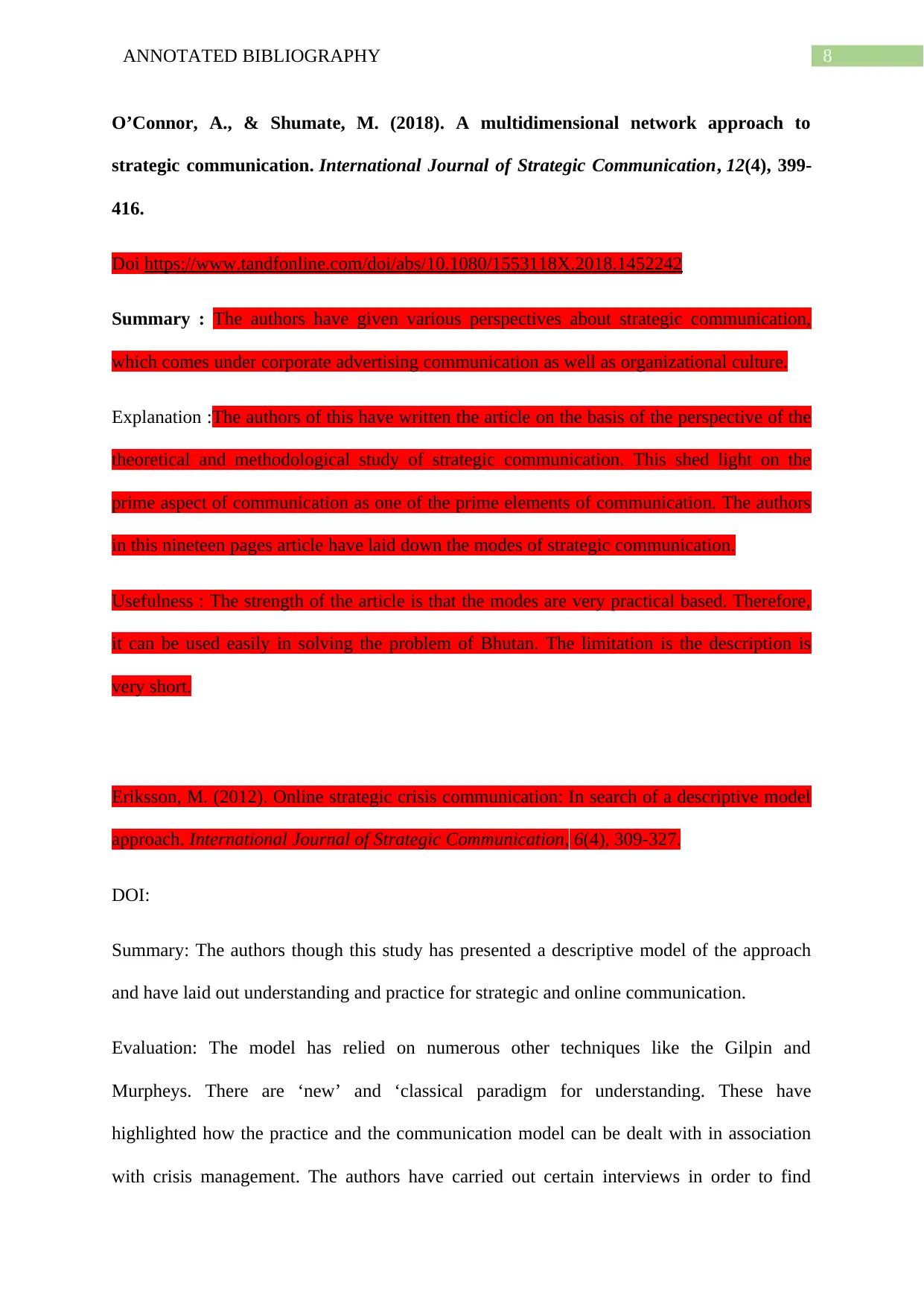
8ANNOTATED BIBLIOGRAPHY
O’Connor, A., & Shumate, M. (2018). A multidimensional network approach to
strategic communication. International Journal of Strategic Communication, 12(4), 399-
416.
Doi https://www.tandfonline.com/doi/abs/10.1080/1553118X.2018.1452242
Summary : The authors have given various perspectives about strategic communication,
which comes under corporate advertising communication as well as organizational culture.
Explanation :The authors of this have written the article on the basis of the perspective of the
theoretical and methodological study of strategic communication. This shed light on the
prime aspect of communication as one of the prime elements of communication. The authors
in this nineteen pages article have laid down the modes of strategic communication.
Usefulness : The strength of the article is that the modes are very practical based. Therefore,
it can be used easily in solving the problem of Bhutan. The limitation is the description is
very short.
Eriksson, M. (2012). Online strategic crisis communication: In search of a descriptive model
approach. International Journal of Strategic Communication, 6(4), 309-327.
DOI:
Summary: The authors though this study has presented a descriptive model of the approach
and have laid out understanding and practice for strategic and online communication.
Evaluation: The model has relied on numerous other techniques like the Gilpin and
Murpheys. There are ‘new’ and ‘classical paradigm for understanding. These have
highlighted how the practice and the communication model can be dealt with in association
with crisis management. The authors have carried out certain interviews in order to find
O’Connor, A., & Shumate, M. (2018). A multidimensional network approach to
strategic communication. International Journal of Strategic Communication, 12(4), 399-
416.
Doi https://www.tandfonline.com/doi/abs/10.1080/1553118X.2018.1452242
Summary : The authors have given various perspectives about strategic communication,
which comes under corporate advertising communication as well as organizational culture.
Explanation :The authors of this have written the article on the basis of the perspective of the
theoretical and methodological study of strategic communication. This shed light on the
prime aspect of communication as one of the prime elements of communication. The authors
in this nineteen pages article have laid down the modes of strategic communication.
Usefulness : The strength of the article is that the modes are very practical based. Therefore,
it can be used easily in solving the problem of Bhutan. The limitation is the description is
very short.
Eriksson, M. (2012). Online strategic crisis communication: In search of a descriptive model
approach. International Journal of Strategic Communication, 6(4), 309-327.
DOI:
Summary: The authors though this study has presented a descriptive model of the approach
and have laid out understanding and practice for strategic and online communication.
Evaluation: The model has relied on numerous other techniques like the Gilpin and
Murpheys. There are ‘new’ and ‘classical paradigm for understanding. These have
highlighted how the practice and the communication model can be dealt with in association
with crisis management. The authors have carried out certain interviews in order to find
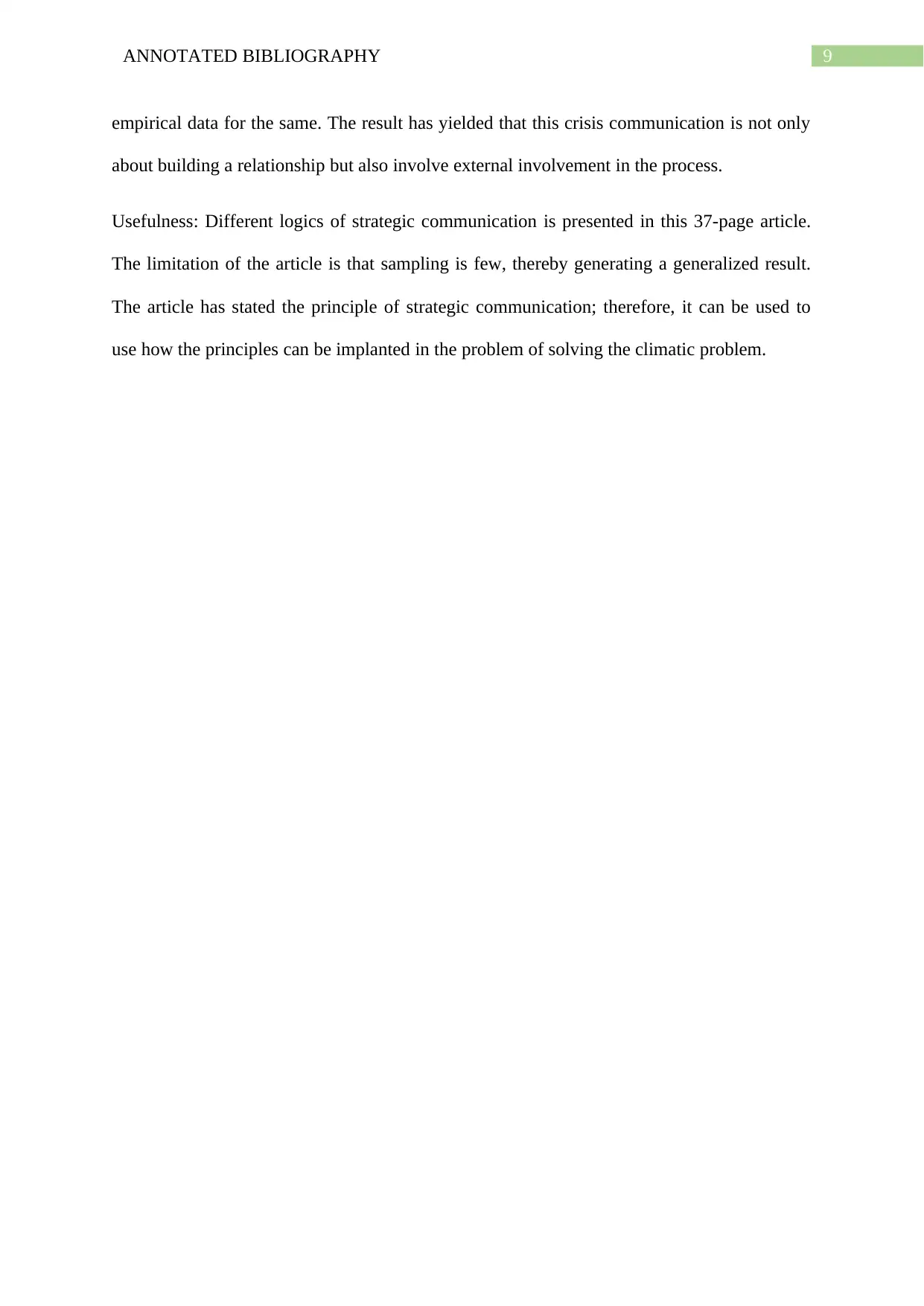
9ANNOTATED BIBLIOGRAPHY
empirical data for the same. The result has yielded that this crisis communication is not only
about building a relationship but also involve external involvement in the process.
Usefulness: Different logics of strategic communication is presented in this 37-page article.
The limitation of the article is that sampling is few, thereby generating a generalized result.
The article has stated the principle of strategic communication; therefore, it can be used to
use how the principles can be implanted in the problem of solving the climatic problem.
empirical data for the same. The result has yielded that this crisis communication is not only
about building a relationship but also involve external involvement in the process.
Usefulness: Different logics of strategic communication is presented in this 37-page article.
The limitation of the article is that sampling is few, thereby generating a generalized result.
The article has stated the principle of strategic communication; therefore, it can be used to
use how the principles can be implanted in the problem of solving the climatic problem.
Secure Best Marks with AI Grader
Need help grading? Try our AI Grader for instant feedback on your assignments.
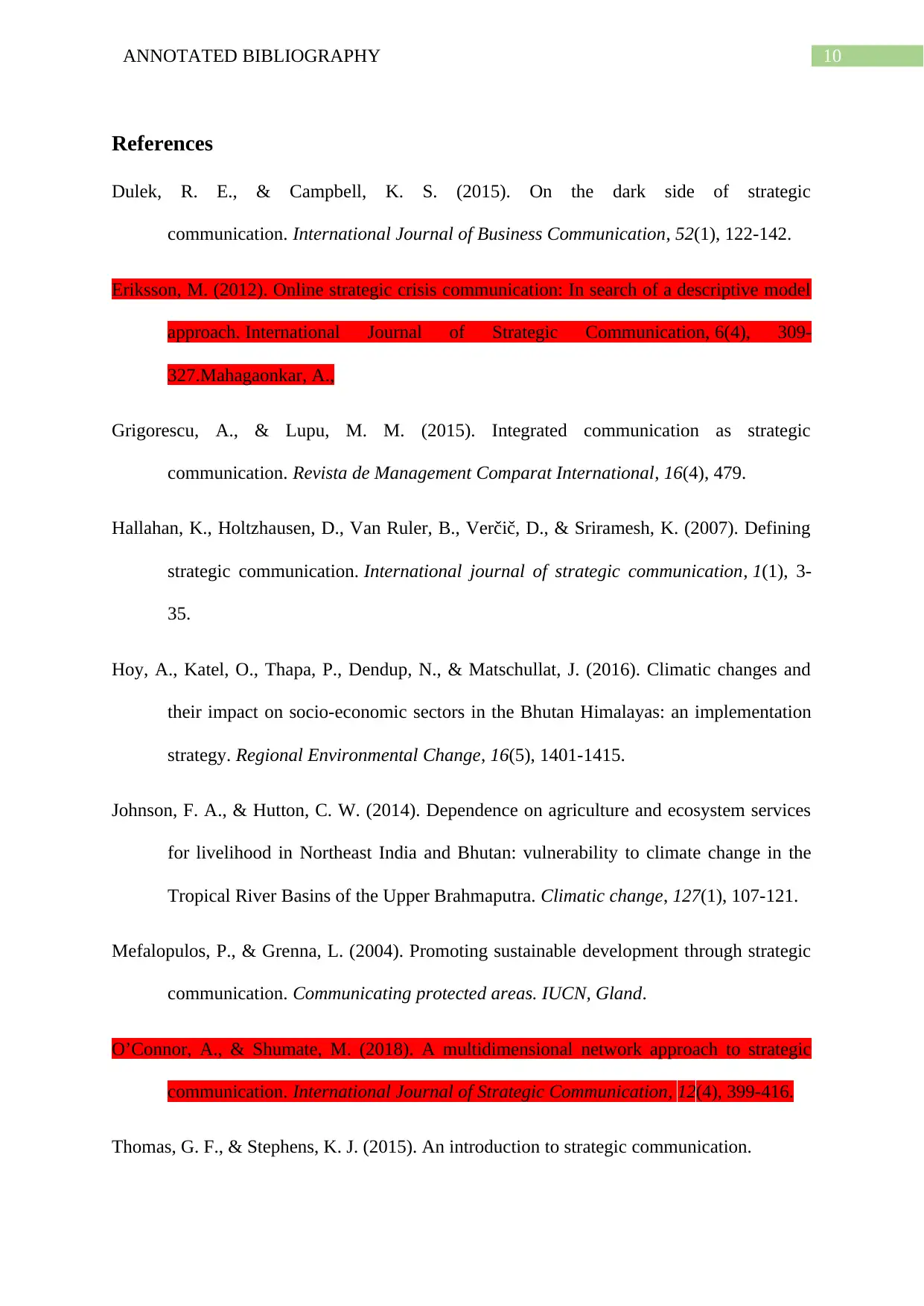
10ANNOTATED BIBLIOGRAPHY
References
Dulek, R. E., & Campbell, K. S. (2015). On the dark side of strategic
communication. International Journal of Business Communication, 52(1), 122-142.
Eriksson, M. (2012). Online strategic crisis communication: In search of a descriptive model
approach. International Journal of Strategic Communication, 6(4), 309-
327.Mahagaonkar, A.,
Grigorescu, A., & Lupu, M. M. (2015). Integrated communication as strategic
communication. Revista de Management Comparat International, 16(4), 479.
Hallahan, K., Holtzhausen, D., Van Ruler, B., Verčič, D., & Sriramesh, K. (2007). Defining
strategic communication. International journal of strategic communication, 1(1), 3-
35.
Hoy, A., Katel, O., Thapa, P., Dendup, N., & Matschullat, J. (2016). Climatic changes and
their impact on socio-economic sectors in the Bhutan Himalayas: an implementation
strategy. Regional Environmental Change, 16(5), 1401-1415.
Johnson, F. A., & Hutton, C. W. (2014). Dependence on agriculture and ecosystem services
for livelihood in Northeast India and Bhutan: vulnerability to climate change in the
Tropical River Basins of the Upper Brahmaputra. Climatic change, 127(1), 107-121.
Mefalopulos, P., & Grenna, L. (2004). Promoting sustainable development through strategic
communication. Communicating protected areas. IUCN, Gland.
O’Connor, A., & Shumate, M. (2018). A multidimensional network approach to strategic
communication. International Journal of Strategic Communication, 12(4), 399-416.
Thomas, G. F., & Stephens, K. J. (2015). An introduction to strategic communication.
References
Dulek, R. E., & Campbell, K. S. (2015). On the dark side of strategic
communication. International Journal of Business Communication, 52(1), 122-142.
Eriksson, M. (2012). Online strategic crisis communication: In search of a descriptive model
approach. International Journal of Strategic Communication, 6(4), 309-
327.Mahagaonkar, A.,
Grigorescu, A., & Lupu, M. M. (2015). Integrated communication as strategic
communication. Revista de Management Comparat International, 16(4), 479.
Hallahan, K., Holtzhausen, D., Van Ruler, B., Verčič, D., & Sriramesh, K. (2007). Defining
strategic communication. International journal of strategic communication, 1(1), 3-
35.
Hoy, A., Katel, O., Thapa, P., Dendup, N., & Matschullat, J. (2016). Climatic changes and
their impact on socio-economic sectors in the Bhutan Himalayas: an implementation
strategy. Regional Environmental Change, 16(5), 1401-1415.
Johnson, F. A., & Hutton, C. W. (2014). Dependence on agriculture and ecosystem services
for livelihood in Northeast India and Bhutan: vulnerability to climate change in the
Tropical River Basins of the Upper Brahmaputra. Climatic change, 127(1), 107-121.
Mefalopulos, P., & Grenna, L. (2004). Promoting sustainable development through strategic
communication. Communicating protected areas. IUCN, Gland.
O’Connor, A., & Shumate, M. (2018). A multidimensional network approach to strategic
communication. International Journal of Strategic Communication, 12(4), 399-416.
Thomas, G. F., & Stephens, K. J. (2015). An introduction to strategic communication.
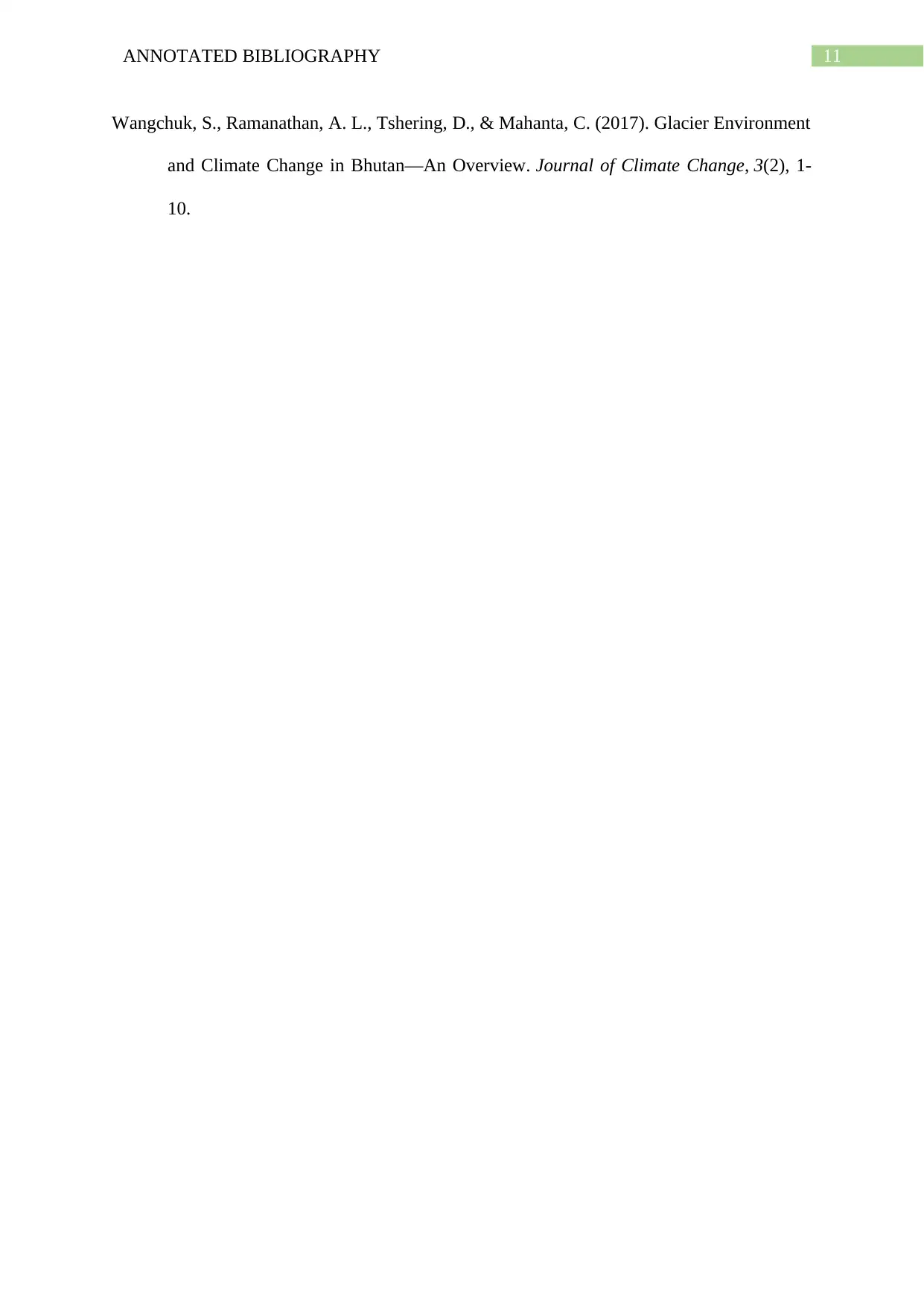
11ANNOTATED BIBLIOGRAPHY
Wangchuk, S., Ramanathan, A. L., Tshering, D., & Mahanta, C. (2017). Glacier Environment
and Climate Change in Bhutan—An Overview. Journal of Climate Change, 3(2), 1-
10.
Wangchuk, S., Ramanathan, A. L., Tshering, D., & Mahanta, C. (2017). Glacier Environment
and Climate Change in Bhutan—An Overview. Journal of Climate Change, 3(2), 1-
10.
1 out of 12
Related Documents
Your All-in-One AI-Powered Toolkit for Academic Success.
+13062052269
info@desklib.com
Available 24*7 on WhatsApp / Email
![[object Object]](/_next/static/media/star-bottom.7253800d.svg)
Unlock your academic potential
© 2024 | Zucol Services PVT LTD | All rights reserved.





